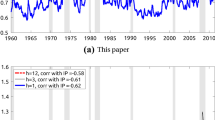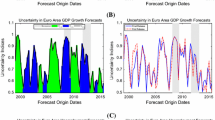Abstract
A noteworthy characteristic of empirical studies on the economic uncertainty index is that very few published papers depend on normative analysis. Therefore, normative analysis cannot be used to refute the precision of the economic uncertainty index; the lack of precision is simply the outcome of a misspecification of a commonly used model and a complex data collection process. To overcome this shortcoming, this paper uses the optimal form of the economic uncertainty index and determines its empirical validity based on a sample of 7 countries, including 3 developed and 4 developing countries. Using a grid search optimization procedure, the findings provide some policy implications; the optimal economic uncertainty index can characterize the uncertainty level of macroeconomic conditions and serve as a guiding policy tool for improving uncertainty levels in macroeconomic conditions. The estimated response function of the optimal economic uncertainty index suggests that the exchange rate, inflation, interest rate and output are useful indicators for central banks’ decision-making and that the optimal index supports the prediction of economic uncertainty.


Similar content being viewed by others
Notes
The systemic financial risk entails crises that result in a sharp decline in economic activities and asset values (cf. World Economic Forum 2008, p. 7).
In this paper, the potential value is computed by running the Hodrick-Prescott filter on the actual value. The potential variable can also be estimated by employing the Baxter and King (BP) filter and the unobservable components (UC) model. Their results did not vary a great deal compared to the Hodrick-Prescott approach.
One may use other optimization algorithms, such as the SIMPLEX algorithm, the GENETIC search method or the BFGS algorithm, to find the optimal reaction coefficients; however, this approach is not advisable when the models are large (Levieuge 2008).
One may soften the economic policy to mitigate the negative level of the economic uncertainty index if the above process is the other way round.
The real exchange rate used in this paper is the real effective exchange rate (REER). Real appreciation means that the value of the domestic currency is increasing relative to its trading partners, and real depreciation means that the value of the domestic currency is decreasing relative to its trading partners.
Cf. Golob (1994) for a further discussion of how economic uncertainty interacts with the economy.
In our example, given \(A_{1}\), we assume that \(\Omega \) is the identity matrix.
The sample RATS codes (for the grid search procedure) in estimating the optimal economic uncertainty index and the loss function are available online at https://staf-digital.upsi.edu.my/Fakulti/FPE/gan.pt/Optimaleconomicuncertaintyindex_US_forCE_.PRG (Note this sample program works when executed in RATS version 6.1 onwards).
See Cf. International Monetary Fund (2005) for further explanations of the real effective exchange rate.
The real interest rate is measured as the difference between the nominal interest rate and the rate of inflation.
Equation 5 is not included in the GMM method because the actual estimate of economic uncertainty index cannot be determined; however, the optimal form (i.e., best form) of the economic uncertainty index could be found through the use of the grid search optimization procedure.
The Phillips-Perron unit root test allows us to reject the null hypothesis regarding the existence of a non-stationary or unit root.
This paper presents only a short summary of the results because the complete results require more space than is allowed here.
References
Allison, T., & Suwanraks, R. (1999). Financial reforms in Thailand. Thailand Development Research Institute Quarterly Review, 14(4), 6–18.
Apergis, N. (1999). Inflation uncertainty and money demand: Evidence from a monetary regime change and the case of Greece. International Economic Journal, 13(2), 21–30.
Atta-Mensah, J. (2004). Money demand and economic uncertainty. Bank of Canada Working Paper No. 2004–25.
Ball, L. (1997). Efficient rules for monetary policy. National Bureau of Economic Research Working Paper No. 5952.
Ball, L. (1999). Policy rules for open economies. In J. Taylor (Ed.), Monetary policy rules (pp. 129–156). Chicago: University of Chicago Press.
Bean, C. (2011). Joseph Schumpeter lecture the great moderation, the great panic, and the great contraction. Journal of the European Economic Association, 8(2), 289–325.
Bernanke, B. S. (2010a). On the implications of the financial crisis for economics. Speech Presented at the Center for Economic Policy Studies and the Bendheim Center for Finance. Princeton, New Jersey. http://www.federalreserve.gov/newsevents/speech/bernanke20100924a.htm. Accessed 25 May 2011.
Bernanke, B. S. (2010b). Monetary policy and the housing bubble. Speech Presented at the annual meeting of the American Economic Association. Atlanta, Georgia. www.federalreserve.gov/newsevents/speech/bernanke20100103a.htm, Accessed 25 May 2011.
Berument, H., & Dincer, N. N. (2005). Inflation and inflation uncertainty in the G-7 countries. Physica A, 348, 371–379.
Bofinger, P., & Wollmershauser, T. (2001). Managed floating: Understanding the new international monetary order. Economic Papers No: 30, University of Wurzburg.
Burger, P., & Knedlik, T. (2004). The MCI as a monetary policy guide in a small, open emerging market economy. South African Journal of Economics, 72(2), 366–384.
Caplin, A., & Schotte, A. (2008). The foundations of positive and normative economics: A handbook. Oxford: Oxford University Press.
Casellina, S., & Uberti, M. (2008). Optimal monetary policy and long-term interest rate dynamics: Taylor rule extensions. Computational Economics, 32(1), 183–198.
Choi, W. G., & Oh, S. (2003). A money demand function with output uncertainty, monetary uncertainty, and financial innovations. Journal of Money, Credit and Banking, 35(5), 685–709.
Clarida, R., Gali, J., & Gertler, M. (1998). Monetary policy rules in practice: Some international evidence. European Economic Review, 42(6), 1033–1067.
Cronin, D., Kelly, R., & Kennedy, B. (2010). Money growth, uncertainty and macroeconomics activity: A multivariate GARCH analysis. Empirica, 38(2), 155–167.
Du, H., Wang, J., Watzl, J., Zhang, X., & Hu, Z. (2008). Classification structure-activity relationship (CSAR) studies for prediction of genotoxicity of thiophene derivatives. Toxicology Letters, 177(1), 10–19.
Edge, R. M., Laubach, T., & Williams, J. C. (2010). Welfare-maximizing monetary policy under parameter uncertainty. Journal of Applied Econometrics, 25(1), 129–143.
Ellsberg, D. (1961). Risk, ambiguity, and the savage axioms. The Quarterly Journal of Economics, 75(4), 643–669.
Engle, R. F. (1982). Autoregressive conditional heteroskedasticity with estimates of the variance of United Kingdom inflation. Econometrica, 50(4), 987–1007.
Epstein, L. G. (1999). A definition of uncertainty aversion. Review of Economic Studies, 66(3), 579–608.
Fane, G. (2005). Post-crisis monetary and exchange rate policies in Indonesia, Malaysia and Thailand. Bulletin of Indonesian Economic Studies, 41(2), 175–195.
Feldstein, M. (2010). What power for the Federal Reserve? Journal of Economic Literature, 48(1), 134–145.
Gali, J., & Gertler, M. (1999). Inflation dynamic: A structural econometric approach. Journal of Monetary Economics, 44(2), 195–222.
Golob, J. E. (1994). Does inflation uncertainty increase with inflation? Economic Review (Federal Reserve Bank of Kansas City), 3, 27–38.
Guender, A. (2005). On optimal monetary policy rules and the Role of MCIs in the open economy. Open Economies Review, 16(2), 189–207.
Hall, T. E., & Noble, N. R. (1987). Velocity and the variability of money growth: Evidence from Granger causality tests. Journal of Money, Credit and Banking, 19(1), 112–116.
Hataiseree, R., & Rattanalungkarn, T. (1998). Strategies for Thailand’s monetary policy operations in the year 2000: Inflation targeting versus monetary targeting? Bank of Thailand Monthly Bulletin, 38(11), 11–42.
International Monetary Fund. (2005). International financial statistic yearbook. International Monetary Fund Statistics Department.
International Monetary Fund. (2009). World economic outlook: World economic and financial surveys. Washington, DC: International Monetary Fund.
Ito, T., & Hayashi, T. (2004). Inflation targeting in Asia. Occasional Paper 1, Hong Kong Institute for Monetary Research.
Jaaskela, J. P. (2005). Inflation, price level and hybrid rules under inflation uncertainty. Scandinavian Journal of Economics, 107(1), 141–156.
Jondeau, E., & Bihan, H. L. (2000). Evaluating monetary policy rules in estimated forward-looking models: A comparison of US and German monetary policies. Banque de France Notes D’Etudes Et De Recherché 76.
Jondeau, E., & Sahuc, J. (2008). Optimal monetary policy in an estimated DSGE model of the Euro area with cross-country heterogeneity. International Journal of Central Banking, 4(2), 23–72.
Knight, F. H. (1921). Risk, uncertainty, and profit. Boston: The Riverside Press.
Levieuge, G. (2008). Implementing the Svensson’s approach to determine simple optimal monetary policy with ESTIMA RATS. In Collection Lecture & Methodologie 2008–01. Laboratoire d’Economies D’Orleans.
Levin, A., & Williams, J. C. (2003). Robust monetary policy with competing reference models. Journal of Monetary Economics, 50(5), 945–947.
Makinen, G. E. (2008). Current economic conditions and selected forecasts. Congressional Research Service Report RL30329. http://fpc.state.gov/documents/organization/112048.pdf, Accessed 29 May 2011.
Mankiw, N. G., & Reis, R. (2011). Imperfect information and aggregate demand. In B. Friedman & M. Woodford (Eds.), Handbook of monetary economics (Vol. 3(A), pp. 182–230). North Holland: Elsevier.
McCauley, R. N. (2006). Understanding monetary policy in Malaysia and Thailand: Objectives, instruments and independence. Bank for International Settlements Papers 31 (pp. 172–196). http://www.bis.org/pub1/bppdf/bispap31o.pdf, Accessed 25 May 2009.
Pindyck, R. S., & Rubinfeld, D. L. (1998). Econometric models and economic forecasts. New York: McGraw-Hill.
Rudebusch, G., & Svensson, L. E. O. (2001). Policy rule for inflation targeting. In J. Taylor (Ed.), Monetary policy rules (pp. 203–263). Chicago: University of Chicago Press.
Ruud, P. (2000). An introduction to classical econometric theory. In Grid search. Oxford: Oxford University Press.
Serletis, A., & Shahmoradi, A. (2006). Velocity and the variability of money growth: Evidence from a VARMA. GARCH-M model. Macroeconomic Dynamics, 10(5), 652–666.
Smets, F. (2002). Output gap uncertainty: Does it matter for the Taylor rule? Empirical Economics, 27, 113–129.
Smets, F. (2003). Maintaining price stability: How long is the medium term? Journal of Monetary Economics, 50(6), 1293–1309.
Svensson, L. E. O. (2000). Open-economy inflation targeting. Journal of International Economics, 50(1), 155–183.
Taylor, J. B. (2009). The financial crisis and the policy responses: An empirical analysis of what went wrong. National Bureau of Economic Research Working Paper No. 14631.
Thornton, J. (1995). Friedman’s money supply volatility hypothesis: Some international evidence. Journal of Money, Credit and Banking, 27(1), 288–292.
Woodford, M. (2003). Interest and prices: Foundations of a theory of monetary policy. Princeton: Princeton University Press.
World Economic Forum (2008). Global risks. Geneva: Global Risk Network of World Economic Forum.
Acknowledgments
The author is very grateful to the anonymous referees for their helpful comments and constructive suggestions. The author would like to thank Professor Dr. Takatoshi Ito from the University of Tokyo, who suggested the idea of positivism and normativism in the study of macroeconomic conditions during a Postgraduate Seminar on 14\(^{\mathrm{th}}\) August 2008 organized by the University of Malaya. Additionally, the author acknowledges financial support from the ’Fundamental Research Grant Scheme (FRGS), Ministry of Higher Education Malaysia’ under Grant 2012-0018-106-02.
Author information
Authors and Affiliations
Corresponding author
Appendix
Rights and permissions
About this article
Cite this article
Gan, PT. The Optimal Economic Uncertainty Index: A Grid Search Application. Comput Econ 43, 159–182 (2014). https://doi.org/10.1007/s10614-013-9366-y
Accepted:
Published:
Issue Date:
DOI: https://doi.org/10.1007/s10614-013-9366-y




